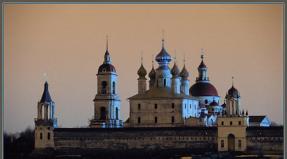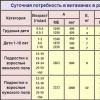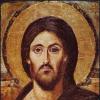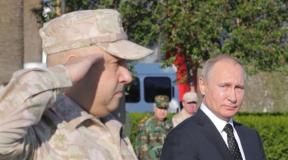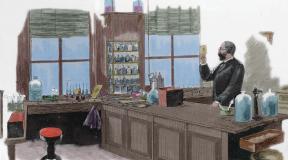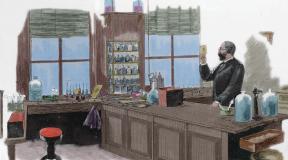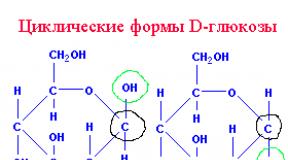Khrushchev's persecution of the Russian Church. Its character and results. "Khrushchev's" persecution of the Church as a struggle for liberation from the Stalinist legacy Anti-religious campaign 1954 1964
Priest Vladislav Musikhin, lecturer in the history of the Russian Church at the Yekaterinburg Theological Seminary, answers questions from viewers. Transfer from Yekaterinburg. Aired June 4, 20104
Hello dear viewers! On the air of the TV channel "Soyuz" the program "Conversations with the priest". In the studio Timofey Obukhov.
Today, as a guest, I am glad to welcome Priest Vladislav Musikhin, rector of the Church of All Saints at the Northern Cemetery in Yekaterinburg, teacher of the Yekaterinburg Theological Seminary on the subject "History of the Russian Church XX century".
Father, hello! Bless our viewers.
Good evening. Lord bless you all.
The topic of our today's conversation is "Khrushchev's persecution of the Church", since 2014 marks fifty years since the removal of N.S. Khrushchev from all positions. We know him as the initiator of the persecution that the Russian Orthodox Church endured in those years.
Indeed, October 14 this year marks the 50th anniversary of the resignation of Nikita Sergeevich Khrushchev from all his posts. We know that this is the day of the Intercession of the Most Holy Theotokos. Of course, the then rulers of the country did not time their resignation to coincide with this date, it turned out providentially. We know that the Mother of God is the patroness of our land, and the Russian land is often called one of the inheritances of the Mother of God.
If we talk about the persecution itself, they lasted for six years from 1958 to 1964. There was a whole range of reasons why Khrushchev and his inner circle initiated the persecution of the Russian Orthodox Church.
First, it must be said that the Russian Orthodox Church and other religious organizations were persecuted in one way or another throughout the entire period of Soviet power. The task was the gradual eradication of all religious ideas, not only the elimination of religious institutions, but also the eradication of all religious ideas and beliefs. We know that this task has not been removed for all 70 years, there were simply more "quiet" times, when the struggle against faith was limited to such phenomena as: atheistic education from childhood, anti-religious propaganda, and restriction of the activities of religious organizations. There were periods when administrative pressure, repressions, and all kinds of control over the activities of religious organizations increased. One of these periods, one might say, the last serious period of persecution, was the Khrushchev persecution from 1958 to 1964.
There was a whole range of reasons why Khrushchev set the task of eradicating religion in the country in the near future. One of the reasons was that Nikita Sergeevich was a kind of utopian romantic, he sincerely believed in the possibility of building a bright communist future, the possibility of a communist paradise on earth: when there are no commodity-money relations, universal happiness will reign and the like.
According to the Marxist-Leninist ideology, there can be no place for any religion under communism. Since the accelerated task of building communism was set by a certain date - approximately by the end of the 70s - the beginning of the 80s of the XX century, it was planned to complete the fight against religion by the same date. Many people know that Khrushchev promised to show on television in 1980 the last "Soviet priest". The promise was made in the early sixties, it was a specific goal, since the building of communism was directly related to the fight against religion.
Question from a TV viewer from Stavropol: Please tell me why the expression "religion is the opium of the people" was popular in Soviet times?
This expression was once uttered by Vladimir Ilyich Lenin. Maybe there is some truth in this: opium relieves suffering, and was used for severe pain. According to our anti-religious rulers, this was the only function of religion. The people lived hard in tsarist times, and religion was needed in order to provide temporary psychological assistance in their suffering and sorrows.
We, as believers, know that this is only a small part of religion. If we believe in our faith, then the price of all "action" is worthless, then, indeed, there will be deception. We know that every believer has experienced a mystical experience of meeting God, which cannot be expressed in words, he knows for sure that God exists, and the memory of this meeting remains with a person forever, even if he departs from God and the Church due to his sins. Having experienced a personal meeting with God, he can no longer become a completely unbelieving person.
During the reign of Lenin and Stalin, in the 20-30s, the Union of Militant Atheists was organized - an organization of an all-Union scale, which at the same time included more than five million people throughout the Soviet Union. This huge organization was engaged in the publication of anti-religious literature: books, magazines, took care of many anti-religious theaters, exhibitions, museums, and the like.
At the end of 1931, the so-called "godless five-year plan" was announced. It was the time of five-year plans in the country. The goal of the complete destruction of all religions in the Soviet Union was set for the next five years. The task is completely utopian, since it was necessary not only to close all churches, church institutions, to destroy all priests, but also, as it was declared, "by May 1, 1937, the name of God must be forgotten throughout the USSR." Even the memory of God had to be eradicated from consciousness.
It was possible to drive the Church into the catacombs, completely destroy the visible legal organization, but completely destroy the faith itself was unrealistic.
- Question of a TV viewer: My question is about the time of NikolaiII. Back in 1904, Nikolai II wrote in a letter to Pobedonostsev that he wished for a Church Council to be held, but more than ten years passed before the Local Council took place. Could you explain the attitude of the tsar himself and this delay in holding the Council, and could this fact be reflected in the state of the people, which made possible the revolution in our country?
Firstly, I’ll say right away that I don’t know about the existence of such a letter from Nicholas II in 1904 to the Chief Prosecutor of the Synod Georgy Pobedonostsev.
I can tell you what I know: in 1905, when the first revolution took place, manifestos were adopted on religious tolerance, the State Duma, and so on. Including very broad freedom was given to many religious organizations not of the Russian Orthodox Church, the Russian Orthodox Church remained in its former position: it was state-owned, the most massive, but at the same time it was subordinate to the state and dependent on state power. As a result, the question arose that the Russian Orthodox Church should also be given freedom. For more than two hundred years, since the time of Emperor Peter I, the moment the Holy Synod was established in 1721, the Church has been in such a subordinate position.
The question was raised that it is necessary to convene an All-Russian Local Council in order to resolve all the issues that have accumulated over two centuries in the life of the Russian Orthodox Church: its relations with the state, internal issues: diocesan, parish life, and so on. About what they began to write to Nicholas II. Written by the leading member of the Holy Synod, Metropolitan Anthony (Vadkovsky). The emperor as a whole reacted positively to the idea of the Council, but since there were vague events after the revolution of 1905, he said that it was necessary to wait for some time.
Chief Procurator Pobedonostsev was a sharp opponent of the convening of the Local Council and the restoration of the patriarchate, and he had a huge influence on the sovereign, which must also be taken into account.
In 1907, the Synod repeatedly appealed to the emperor with a request to convene the Council in the near future. The emperor again postponed the convocation, it is difficult to indicate the reason. Years passed, there were two Pre-Council bodies for the preparation of the Council: the Pre-Council presence, the Pre-Council meeting. In 1914, the Pre-Council Meeting ended its work, the First World War began, and the Cathedral was not created until February 1917, when the revolution and the abdication of the emperor took place. It could not be delayed any longer. According to the coronation act of Paul I in 1799, the emperor was officially the head of the Church. After the emperor left the political scene, the Church was actually beheaded. It was necessary to urgently convene a Council, first of all, in order to resolve issues of the heading of the Church, then to resolve all the issues that were raised at the beginning of the century.
Viewer's question: Is it true that at the initiative of Trotsky, a monument to Judas was erected in one of the cities of the then Soviet Union?
There is a saying that "the most terrible persecution of the Church is the absence of persecution." Christ said: as they persecuted me, they will persecute you also. What is your opinion?
I heard about the monument to Judas, met publications, but did not study this issue in detail. As far as I know, it did not last long, because the monument to the traitor - a figure unambiguously negative among the people - did not add respect to the existing government.
Persecution has a purifying effect in many ways. In times of persecution, it is clear who is who. As long as there is no persecution, as the Savior says, wolves in sheep's clothing can be in the Church, that is, they can be formally. In the face of persecution, when there is a choice between maintaining one's own comfort, well-being or devotion to faith, Christ, the Church, a person opens up for who he really is. From the first days of post-revolutionary persecution, there were clergy who stopped serving, went to secular work, sometimes even began to join the ranks of the persecutors, to join the Bolshevik party.
We know that in 1922 a Renovationist schism arose, which was provoked by the Soviet secret services with the aim of destroying the Church. During the campaign to seize church valuables in the spring of 1922, the most loyal to this action priests were identified, who were promised all kinds of incentives and benefits, and who agreed to follow all the orders of the authorities. Church power was seized: Patriarch Tikhon was arrested, they seized the Patriarchal Chancellery and announced that now the fullness of power was in their hands. Only thanks to the devotion of the people to the canonical church authority, the foundations, canons and dogmas of the Orthodox Church, which these renovationists tried to reform, which is why they are called that, this schism bogged down and did not achieve its goals.
As for Khrushchev's persecution, at that time there was individual, purposeful work with each priest. There were not as many priests in the country as in the 1920s and 1930s; there were just over ten thousand clergy throughout the Soviet Union, most of them serving in Ukraine. Each priest met with a representative, a representative of the KGB and other organizations, who persuaded "carrot and stick" to renounce God and the Church and join the ranks of anti-religious atheists, who travel with lectures throughout the country, say that there is no God, and tell how they used to deceive people. About 200 clergy out of 10,000 were persuaded to the path of betrayal - this is about 2%. It is a lot or a little - it is difficult to judge, but the fact itself was.
We can say that persecution is a test, and few survive these tests. Many of those who renounced, repented and returned to the Church, someone, on the contrary, completely despaired and ended up committing suicide, like Judas. The cases were different, but none of them completed their lives safely.
Question from a TV viewer from the Stavropol Territory: When there are political strife, it is always a struggle for power. But why is it always touched upon a religious theme, especially a Christian one, as it is now: in Syria, in Ukraine. As if people do not know what they are doing, because even now the politicians of Kyiv proclaim Orthodoxy, while they are not believers?
The viewer has already answered the question, citing the words of the Savior that they do not know what they are doing. Of course, even the evil one tempts people.
It is also evidence that the religious component is important in our time, it determines, in many ways, the meaning of our life. And it can be good, as in the Christian faith, or it can be inverted, when a person serves evil, but justifies it with his religious beliefs, like, for example, Islamic terrorists in Syria who take hostages, kill people and believe that they serve God. We remember the words of the Savior that the time will come when "everyone who kills you will think that by doing so he is serving God." This has happened in history, is happening and, unfortunately, will continue to happen.
Therefore, proper religious education is very important. No world religion teaches evil, killing in the name of one's religious beliefs. These are all distortions, perversions of religion. A person actually serving Satan, the enemy of the human race, continues to think that he is serving God. We see this in Syria and elsewhere. According to statistics, Christianity remains the most persecuted religion in the world.
The Lord foretold persecution, and the apostle Paul said that all who want to live godly in Christ Jesus will be persecuted. This must always be remembered, it has always been, at all times, even if we live in an outwardly prosperous society, where there is no persecution, as was the case in pre-revolutionary Russia, which was an Orthodox country. A pious person who is striving for salvation will experience some kind of oppression that is stirred up by the enemy of the human race. People, without realizing it, can, under the temptation of the evil one, act against this person.
Question from a TV viewer from Karelia: I am 61 years old, and I was baptized in the Khrushchev times at home, without a father and without a godfather. Do I need to be re-baptized?
During Khrushchev's persecution, children were completely excommunicated from the Church. In most dioceses, it was strictly forbidden to let children into churches. There were instructions, prohibitions and threats to the priest and the bishop. Since the priests themselves would not fulfill such requirements, a policeman was placed near the temple, who did not let underage young people into the temple.
Of course, under these conditions it was very difficult to baptize a child, an infant. There was even a danger of deprivation of parental rights of those parents who introduced their children to the Church. Such cases were real. Everything belongs to the state, and the child is also, first of all, a Soviet citizen who should be brought up in atheism, and not religious obscurantism, as it was then called.
As we know, out of need, due to circumstances, any Orthodox Christian can baptize a child with three immersion in water, with the baptismal formula "a servant of God is baptized." Of course, this baptism must be supplemented with those prayers that are pronounced by the priest in the temple, and most importantly, supplemented with the Sacrament of Confirmation, which is performed immediately after the Sacrament of Baptism.
You must definitely come to the temple of God, tell your story and ask that they supplement the baptism that was performed on you, because without this it is impossible to proceed to other sacraments, first of all, to confess and take communion. It is necessary to undergo chrismation.
Question from a TV viewer from Kamensk-Uralsky: The Gospel says about forgiving your enemies. Why is it still impossible to bury Lenin in a Christian way, and keep him in a mausoleum?
This question should not be asked of the Church. As far as I know, both Patriarch Alexy II and Patriarch Kirill have repeatedly spoken about the need to bury Vladimir Ilyich Lenin. Another question is about Christian burial, if the person himself rejected Christianity. How much his soul will be pleased with the Christian burial of the Church, which he hated, because we cannot violate the free will of man.
The question is not whether we forgive, the Lord forgives everyone. Does the person need forgiveness?
Probably, it would be advisable to bury the body of V.I. Lenin, but this issue is largely political. As far as I know, our state does not dare to do this, as long as there are enough people in the country with communist convictions, for whom "Lenin is our everything", in order to avoid social discontent. The time will come - of course, they will bury. When this is done, the state will decide.
What do you think, the people who were in power, Nikita Sergeevich's entourage, including himself, did they really not undergo a meeting with God in their lives?
Of course, we cannot know this, it is hidden from the eyes of people. Apparently, they did not survive, or someone survived, and then, like Judas, he departed from God and the Church and consciously fought.
Many believe that if a person has known God, he can no longer become a persecutor and a God-fighter. But this is not so, we know that demons, who are personalities and know perfectly well that God exists, they consciously fight with Him. As the apostle says: even the demons believe and tremble.
I think that such a tragedy can also happen in a person's life when a person begins to consciously struggle with God. He cannot deny the obvious evidence of the existence of God, but at the same time he consciously continues his fight against God. This is probably evidence of the depravity of man. We are all sick, we all carry a nature corrupted by sin to one degree or another. If a person does not fight, does not repent, does not try to improve, he can gradually reach a devil-like state, as the holy fathers said about this. We know that the Antichrist who will come in the last times will be a conscious adversary of God.
People who fought with the Orthodox Church, believers, committed great sins. Will their living children and grandchildren have to answer for their sins?
It's impossible to say for sure. We know from the Old Testament that the sins of the fathers will be reflected on the children until the fourth generation. The son is not responsible for the father. It does not mean that the son will actually be punished, but the depravity that a person carried on himself is somehow transmitted genetically. All of us from Adam and Eve bear a nature corrupted by sin. From medicine we know that if a person, for example, suffered from deep alcoholism, then his children will be prone to it, and it is better for them to refrain from drinking alcohol.
Of course, if there were persecutors among the ancestors, those who were, perhaps, in firing squads, and the person knows about it, then, first of all, we can help our ancestors with our own Christian life. Even not so much by praying for them, because they were conscious atheists, but by their Christian life. There are many testimonies when a person, by his own righteous life, brought to God people who were related by blood, but who were far from God.
We are well aware of the expression of St. Seraphim of Sarov "Acquire the spirit of peace, and around you thousands will be saved." This applies not only to our life now, but also to our relatives. My opinion is that a person who is being saved may not save relatives who were theomachists, but to one degree or another it will alleviate their fate. It is difficult to talk about it specifically, because only the Lord Himself knows about it.
Question from a TV viewer from St. Petersburg: My childhood fell on the time of Khrushchev's persecution, and I see what role this played in my life. I remember the emotional processing of children's consciousness by anti-religious propaganda, when in the third grade we read a story about how a grandmother crushed her granddaughter with a string from a cross. Since that time, such a rejection of God and the Church has been formed.
My parents are conscious communists, and their life, like the life of my children, cannot be called happy. I am 56 years old, I have two children, two years ago I started going to church, the Lord brought me to Himself in incredible ways, but my children cannot come to God. Maybe we need to talk more about the terrible consequences of unbelief.
Thanks for your personal testimony. With age comes the realization that nothing goes without consequences. Seventy years of persistent atheistic propaganda, of a total impact on a person in order to convince that religion is only negative, have not passed without a trace. For a quarter of a century, nothing like this has happened at the state level, but still a lot of people continue to treat the Church with great prejudice. Despite everything the Orthodox Church does, the stereotypes of that time are alive. Even smart, educated people use stupid arguments not only from Khrushchev's time, but also from the 1920s and 1930s. It will probably take a long time for them to disappear.
Question from a viewer from Moldova: In 2012, I was paralyzed, I can't walk. Once I accidentally turned on the Soyuz TV channel and now I constantly watch it, I want to understand the Orthodox faith, how to pray correctly. I really want to go to the temple, but, unfortunately, I can’t move around. What will you advice me?
It just doesn't happen. The Soyuz TV channel is just an example of a positive impact on a person who learns about God. Although a person has not yet fully become a church, also because it is difficult for him to do it physically. But his soul is looking for God, looking for the Truth. Let him who seeks find, as the Lord has said. The Lord knows your ailments and knows your desire to strive for Him. As John Chrysostom says, the Lord kisses the intentions of a person. Of course, the Lord accepts with joy your intention.
We must try to find out through relatives, where the nearest church is located, try to invite a priest, invite them. If you have not been baptized yet, ask to be baptized, invite you to take communion at home. Probably, there are social services that would help those who need church care.
The most important thing is personal striving for God and prayer. We know that in ancient times the desert fathers, who were far from churches, for their holy, righteous ascetic life, received communion from the Angels of God themselves. We meet such cases in the Lives of the Saints.
We must always remember that if our loving Father allowed such a serious illness, it means that this is necessary for the salvation of a person, it can lead him to salvation with the right attitude towards this without much difficulty. The Lord gives his cross to everyone: someone has to work hard and help their neighbors, while someone just needs to endure the illness that the Lord sent, and through this they are also worthy of the Kingdom of Heaven.
Thanks for your detailed answers. Our transmission has come to an end. Please say a few words of farewell to our viewers.
I would like to congratulate all our viewers on the Feast of the Ascension of the Lord, which continues these days until the Feast of the Trinity, Holy Pentecost, when we all pray for the grace of the Holy Spirit to be sent down to us. I congratulate you all on the upcoming Feast of the Holy Trinity. God bless you all.
Host: Timofey Obukhov.
Transcription: Yulia Podzolova.
Stalin's death caused profound changes in the life of the Russian Orthodox Church. Priests began to be released from the camps, first by amnesty, later in rehabilitation . In 1957, divine services were resumed. to Troitsk. Cathedral of the Alexander Nevsky Lavra. All R. 50's was mean. increased reception in all 8 spirits that existed then. seminaries. A great event in church life was the publication of the Bible in Russian in 1956, for the first time since the restoration of the Patriarchate. The New Testament was published as a separate edition. In the 1950s, the number of worshipers in Orthodox churches continued to grow. The city churches were overcrowded. On Sundays and holidays, the number of communicants reached several hundred, during Great Lent in Moscow churches 15-20 thousand people received communion. But the decisive majority of the parishioners were elderly women and those whose youth fell on the war. Among the believers, poorly educated people predominated, but a part of the old intelligentsia also kept in touch with the Church. New intelligentsia, images. in Soviet universities, in the 50s, almost all outside the C-vi. In 1957, the Russian Orthodox Church had 73 dioceses within the USSR, 69 men. and wives. mon-ryami, mainly in the west of the country: Ukraine, Belarus and the Baltic states. In the 2nd floor. In the 1950s, new bishops were consecrated. Moreover, there was a change of generations in the episcopate. Bishops left, ordained. pre-revolution and in the 20-30s, consecrations also left. from widowed archpriests. They were replaced by a new generation, formed. in Soviet times. In the ideological In the midst of 1958, N.S. Khrushchev’s political program appeared, which, among other things, included the struggle to “overcome the religious vestiges of capitalism” in the minds of the Soviet people. Attacks on Christianity intensified in the press. For the first time after the era of the "Militant Atheist" in newspapers and magazines anti-religious articles. The pressure on the Russian Orthodox Church, which united most of the country's believing population, intensified. In anti-religion the campaign involved renegades. In 1958, the atheist came out. brochure, ex. teacher of the Odessa Seminary E. Duluman; in the press there were statements by the ex-protopriests P. Darmansky, A. Spassky and Chertkov about renunciation of God. Dec 5 1959 Pravda published an article by Prof. LDA A. Osipov, banned. in the priesthood for the second marriage, which. he publicly blasphemed God and the Church. After an article in Pravda, his tour of the country began. Output. his atheistic articles and pamphlets. Dec 30 1959 Priest. Synod under the chairmanship of Patr. Alexy decreed: priests who publicly blasphemed God should be considered monsters. from the dignity and deprived of church fellowship and excommunicated from Ts-vi. The closure of churches began, at the insistence of the societies. Speaking at the Conference of the Soviet. public for disarmament 16 Feb. 1960 Patr. Alexy (Simansky) tried to protect the Church from unfair attacks. The speech of the Patriarch did not shield the Ts-v, but, published in the “Journal of Moscow. Patriarchy”, she strengthened the spirit of thousands of faithful servants, embarrassed by persecution. Feb 21 1960 G. G. Karpov was dismissed from the post of Chairman of the Council for the Affairs of the Russian Orthodox Church. V.A. became his successor. Kuroyedov. Since 1961, the fight against religion has become the center of the ideological. task of the party leadership. This was heard in the report of N. S. Khrushchev at the 22nd Congress of the CPSU, in the explanations of the presenters. party ideologist Suslov, in Ilyichev's thesis for June. Plenum of the Central Committee of the CPSU in 1963 that religion is the main and only. legally existing in the country ideological. enemy of Marxism. In December 1965, the Council for the Affairs of the Russian Orthodox Church was merged with the Council for Religious Cults. New institution, led by V.A. Kuroedov, named "Council for Religious Affairs under the Council of Ministers of the USSR." Belarus, Ukraine, Moldova were especially affected. Almost half of the parishes across the country were closed during the Khrushchev persecution. The Kiev-Pechersk Lavra was closed in 1963 under the pretext of restoration and repair. They also tried to close the Pochaev Assumption Lavra, but the monks, led by the rector, managed to defend it. In 1959, the ROC had about 14 thousand parishes, in 1961 it decreased to 8 thousand parishes (by 1966, 7523 parishes had survived). Accordingly, the number of serving priests and deacons also decreased. By 1961, only 8252 priests and 809 deacons remained; by 1967 - 6694 priests and 653 deacons. Reduced admission to the seminary. In the end, 5 seminaries: Stavropol, Saratov, Kyiv, Lutsk, Zhirovitskaya - were closed. In 1959, the ROC had 47 monasteries, and by the mid-1960s. only 16 left; the number of monastics decreased by this time from 3 thousand to about 1.5 thousand. The number of bishops of the Russian Orthodox Church has also decreased; many dioceses began to be ruled by bishops who occupied neighboring sees. resolute difference between Khrushchev's persecutions from those that attacked the Church in the 20s and 30s was that they passed without bloodshed and almost without arrests. True, several clergymen were put on trial (including 2 bishops who actively resisted: Archbishop Job (Kresovich) of Kazan - 3 years, Archbishop Andrei (Sukhenko) of Chernigov - sentenced to 8 years, released ahead of schedule), who were accused, as a rule, in financial crimes, most often associated with non-payment or underpayment of taxes. Priests who were deprived of the opportunity to perform divine services due to the closure of parishes were dismissed from the state or retired. Most of them were elderly people. Some of the middle-aged and younger priests were leaving for the secular service. Although rare, renegades were still among them, who, unlike the first apostates of the late 50s, whose actions were publicized throughout the country, were usually content with appearances in the local press.
Khrushchev's anti-religious campaign (Khrushchev's persecution of religion) is a period of intensification of the struggle against religion in the USSR, which peaked in 1958-1964. Named after the leader of the country at that time - the First Secretary of the Central Committee of the CPSU Nikita Khrushchev. It is Khrushchev who is credited with the public promise allegedly given at the end of the 1950s by the end of the seven-year period, that is, by 1965 (in some sources - by 1975, by 1980) "to show the last priest on TV."
Many researchers and religious figures agree that the Khrushchev campaign was the most difficult time for the religious organizations of the USSR in the post-war period. Thus, the well-known human rights activist and Orthodox priest Georgy Edelstein (a layman during the campaign) described it as a “Khrushchev Sabbath.”
Causes
The American historian Walter Zawatsky suggested two main reasons for the start of the campaign. One of them was Khrushchev's struggle for power. Against the backdrop of the exposure of Stalin's personality cult and the collective leadership of the country proclaimed after Stalin's death, Khrushchev gradually pushed his competitors out of power and began to plant his own personality cult. “If Stalin was restrained and silent, then Khrushchev was forced by his indefatigable nature to“ gush ”for all six years, until his own nominees Brezhnev and Kosygin removed him from the post of head of state,” notes V. Zavatsky.
The second reason, according to Zawatsky, was ideological in nature: “he was a staunch communist, and it was his devotion to communist ideology that explains not only the excesses in educational and agricultural policy, for which Khrushchev got hit hard, but also an attack on religion that was completely unjustified from the point of view of politics ... In both cases, religion became an unnecessary ballast and an extremely convenient scapegoat.”
Peculiarities
Historians identify several features that are characteristic of this particular campaign.
The goal is re-education
Religious scholar Academician L. N. Mitrokhin divided the persecution of religion in the USSR into two stages: "militant atheism" (1920-1930s) and "scientific atheism" (1950-1980s). During the years of "militant atheism" persecution was aimed at the physical extermination of the most active believers, who were seen as carriers of an ideology hostile to the Soviet state. However, during the war years, believers with weapons in their hands proved their devotion to the Soviet Motherland. Therefore, later, during the years of scientific atheism, believers began to be considered part of Soviet society, albeit a “misguided” one. During the years of "scientific atheism" persecution was focused on the "re-education" of believers, as well as exposing them in an unsightly light in the eyes of the rest of society.
The essence of the new political course was defined in the Fourth Program of the Communist Party, adopted in 1961. Here religion is called "remnants of capitalism in the minds and behavior of people," and the struggle against these remnants is "an integral part of the work of communist education."
According to historian Elena Panich, the word "education" became the key word in the new Program of the CPSU. It meant that now the party did not intend to implement the dictatorship of the proletariat, but to educate worthy members of a socialist (and, in the future, communist) society. The “moral code of the builder of communism” written in the same Party Program provided that members of a socialist society should combine “spiritual wealth, moral purity and physical perfection”.
The totality of the campaign
The second feature of the campaign was its unprecedented scope. The fight against religion was carried out not only by the law enforcement system, but also by party and Soviet authorities, management and collectives of enterprises, trade unions, the Komsomol, and public organizations. “This totality of persecution was supposed to create for believers an atmosphere of rejection, cultural isolation, in which they would feel like second-class citizens, outcasts of society, unworthy to enter a bright future together with the whole people. One Soviet poetess wrote in those years: “You can pray freely, but in such a way that only God could hear, ”said historian Vladimir Stepanov.
Anti-sectarian accent
The third distinguishing feature of the campaign was its focus. According to historian Tatyana Nikolskaya, this campaign was waged against all religions and denominations of the USSR, but at the same time it had a pronounced anti-sectarian character. So, if in the 1930s the terms "churchmen" and "sectarians" sounded equally negative, now the word "sectarians" sounded especially abusive. It was to them that a significant number of anti-religious publications in the media, literary works and films were devoted.
Start
As early as July 7, 1954, the Decree of the Central Committee of the CPSU "On major shortcomings in scientific-atheistic propaganda and measures to improve it" was issued. It noted the revival of the activities of the "church and various religious sects" and the growth in the number of citizens practicing religious rites. In this connection, party, Komsomol organizations, the Ministry of Education and trade unions were ordered to carry out anti-religious work "systematically, with all perseverance, by the method of persuasion, patient explanation and an individual approach to believers."
However, we recall that at that time the leadership of the country was still collective and 4 months later (November 10, 1954) a new Decree “On errors in conducting scientific-atheistic propaganda among the population” was adopted .. It condemned the use of slander, insults, administrative interference in the activities of religious organizations, "instead of deploying systematic painstaking work to promote natural science knowledge and the ideological struggle against religion."
As a result, large-scale persecution did not begin. According to historian Dmitry Pospelovsky, "the period 1955-1957 can be considered the most 'liberal' for believers after 1947."
The anti-religious campaign began in full measure after the 20th Congress of the CPSU, when Khrushchev's power was strengthened. The beginning of the campaign can be considered the release of a secret decree of the Central Committee of the CPSU "On the note of the Department of Propaganda and Agitation of the Central Committee of the CPSU for the Union Republics" On the Shortcomings of Scientific and Atheistic Propaganda "" dated October 4, 1958. It obliged party, Komsomol and public organizations to launch a propaganda offensive against "religious survivals."
Methods
Pressure on religious leaders
The central organs of religious organizations in the USSR were close to liquidation as a result of the repressions of the 1930s. However, during the war with Germany (1941-1945), Stalin's policy towards religion softened: in 1943, at the initiative of Stalin, a Council of Bishops of the Russian Orthodox Church was held, which elected Metropolitan Sergius (Stragorodsky) to the Patriarchal throne, and in 1944 the AUCECB was created - the governing body of the united evangelical Christians and Baptists (to which part of the Pentecostals was later attached). The activities of the All-Union Council of Seventh-day Adventists also resumed (which, however, was dissolved in 1960).
Legal religious leaders found themselves in a difficult position: being believers, they were forced all the time to balance between the interests of believers and the political line of an atheistic state. On the one hand, the presence of a centralized leadership allowed confessions to exist legally, which in itself meant a lot in an aggressive environment. On the other hand, in an effort to continue to remain legal, they were forced to look for a compromise, sometimes going too far.
Thus, in December 1959, at the Plenum of the AUCECB, “under pressure from outsiders,” two documents were adopted: “Regulations on the Union of Evangelical Christian Baptists in the USSR” and “Instructive Letter to Senior Presbyters of the AUCECB.” It recommended limiting access to baptism to young people under the age of 30, not bringing children to church services, “outliving” speeches by visiting preachers, home meetings, trips to other communities, helping those in need, and even reciting poetry.
Elders were required to "restrain unhealthy missionary manifestations" (that is, not actually preach to unbelievers) and "strictly observe the legislation on cults" (that is, to carry out legal rather than spiritual work). These demands went against the dogma and beliefs of evangelical Christian Baptists. Dissatisfaction in the communities with these documents, coupled with general dissatisfaction with the methods of Khrushchev's anti-religious campaign, led to unexpected and extremely undesirable consequences both for the state and for the leaders of the AUCECB in the form of the creation of an illegal opposition Council of Churches of the ECB.
Pressure was also exerted on the leadership of the Russian Orthodox Church. After the start of the campaign, throughout 1959, Patriarch Alexy I tried to obtain a personal audience with Khrushchev, but to no avail. He had to meet with the leaders of the Council for the Affairs of the Russian Orthodox Church G. G. Karpov and V. A. Kuroyedov, who put pressure on him.
In 1960, V. A. Kuroyedov carried out an operation to remove from all his posts the second person of the Moscow Patriarchate, Metropolitan Nikolai of Krutitsy and Kolomna (Yarushevich), who refused to meekly cooperate with the authorities in their measures to “restrict religious activity”.
In 1961, under pressure from Kuroyedov, the patriarch limited the role of rectors in parishes to purely liturgical and pastoral duties, transferring all economic and financial functions to the executive bodies of the religious community (parish), that is, the parish council and the headman, who were actually appointed by state authorities. In order to obtain "unanimous approval" of these anti-canonical innovations from the episcopate, the patriarch helped Kuroyedov convene the bishops at the Trinity-Sergius Lavra on June 18, 1961, under the pretext of participating in divine services, and held a Bishops' Council organized there in deep secrecy. An attempt by individual bishops, led by Archbishop Ermogen (Golubev), to achieve their abolition in 1965, after the removal of Khrushchev, was suppressed by the authorities. In 1961, the Council for the Affairs of the Russian Orthodox Church also pushed through the entry of the Russian Orthodox Church into the World Council of Churches.
Propaganda
Before the Great Patriotic War, the Union of Militant Atheists served as the main organ of anti-religious propaganda, but during the war it suspended its activities, and later its functions were transferred to the Knowledge Society, but it was not as massive as the Union of Militant Atheists. The competence of the society "Knowledge" was to conduct anti-religious lectures, train lecturers and prepare methodological literature. Under the auspices of the society, the popular science propaganda journal "Science and Religion" was published.
However, the main role in propaganda was played not by lectures, but by works of cinema, literature and a wave of anti-religious publications in the media. Soviet writers, cinematographers, journalists received a social order for the release of anti-religious works.
During this period, the stories “Miraculous” and “Extraordinary” by V.F. Tendryakov, “The Sinner” by N.S. Evdokimov, “Clouds over Borsk” by S.L. Lungin and I.I. Nusinov, “Save our souls!” S. L. Lvova and others.
Many of them have been made into films. For example, the film "Clouds over Borsk" became a cult film of that time - despite the obvious absurdities of the plot and the authors' ignorance of the object of their work (for example, in the course of the film, the Pentecostals are completely inexplicable from the point of view of their dogma and simply common sense trying to crucify the main character Olga) .
Mass media publications of that time were characterized by high emotionality; they were no longer aimed at proving the truth of atheism, but at inciting hostility towards the rest of the population towards believers. With regard to believers, such emotional epithets as "obscurantists", "saints", "fanatics", etc., were often used (see illustrations for the sections below).
An important role in the propaganda part of the campaign was assigned to anti-religious speeches by former clergy and believers who had denied God. The renunciation of God by the professor of the Leningrad Theological Academy of the Russian Orthodox Church, Archpriest A. A. Osipov, received a great response in December 1959. There were many such cases among Protestants. Newspapers of that time often printed and reprinted such stories (articles of republican newspapers were reprinted by regional, regional - district), many of these articles were then published in separate printed collections.
Some of those who forsook actively participated in the campaign against their former co-religionists: they acted as witnesses for the prosecution at trials against believers, and wrote anti-religious literature. So, A. A. Osipov continued to write anti-church books until his death - a total of 11 books and brochures by this author were published.
What forced the believers to go to betrayal, speaking out against former co-religionists? Probably everyone had their own motives. According to N. P. Goretoy, pastor of the Pentecostal community in the city of Nakhodka, their local "renunciate" Fyodor Myachin was in conflict with his community because of marital infidelity. While working as a driver, he had an accident. And a local KGB officer promised him to release him from criminal liability in exchange for "revealing the savage Pentecostals." Myachin agreed and became the author of the book “My Break with Shaker Sectarians” (see illustration).
Anti-religious films from the campaign
A well-known expert in the field of cinema, Alexander Fedorov, stated: “The Soviet anti-religious films of the 1950s-1980s, maximally sharpened to directly reflect the political decisions of the ‘top’, performed the functions intended for them ‘from above’: they accused the church and believers of various sins and tried to to inculcate atheistic views in a wide audience.” Describing the creative level of their creators, Fedorov noted: “One cannot but admit that the outstanding masters of the screen as a whole sought to distance themselves from anti-religious topics. The atheistic state order was carried out mainly by cinematographers of the second and third rows.
- 1959 - Ivanna
- 1960 - Miraculous
- 1960 - Clouds over Borsk
- 1960 - Love you life
- 1961 - Anathema
- 1961 - Deceived (Latvian. Pieviltie)
- 1962 - Armageddon
- 1962 - Confession
- 1962 - End of the world
- 1962 - Sinner
- 1962 - Sinful Angel
- 1962 - Flower on a stone
- 1962 - Sky Story (cartoon)
- 1963 - Everything remains for people
Administration
One of the main directions of the campaign was the elimination of local religious organizations. The Council for the Affairs of the Russian Orthodox Church and the Council for Religious Affairs (merged into one Council for Religious Affairs in 1965) took measures to de-register (and refuse to register) religious communities, close monasteries, temples, houses of prayer, mosques, synagogues.
In Orthodoxy, out of 8 theological seminaries operating in 1947, only 3 remained after the Khrushchev campaign (of which 2 were attached to academies). Cathedrals were closed in Riga, Poltava, Vinnitsa, Novgorod, Orel; the number of urban and especially rural churches has sharply decreased. In 1963, the total number of Orthodox parishes in the USSR, compared with 1953, was more than halved. In 1959, the Russian Orthodox Church had 47 monasteries, and by the mid-60s only 16 remained, the number of monastics who retained their monastic registration decreased from 3 thousand to 1.5 thousand.
By 1961, 8,252 priests and 809 deacons had “registration” (the right to worship), by 1967 there were 6,694 priests and 653 deacons. The number of bishops was also reduced - a number of dioceses in Ukraine (Dnepropetrovsk, Sumy, Khmelnitsky) and in the Russian Federation (Izhevsk, Ulyanovsk, Chelyabinsk) were forced to switch to the position of neighboring dioceses "temporarily ruled" by bishops. Metropolitans of Kyiv and Leningrad were left without vicar bishops. The Ukrainian Exarchate was deprived of the opportunity to publish the journal Pravoslavniy Visnik, which had been published since 1946.
In a number of regions, the Protestants, despite the large number of believers, did not have a single legal community (for example, in Primorsky Krai). As a result, communities were forced to hold services illegally. At the same time, the Protestants did not need practically any specific accessories for worship, and worship, in extreme cases, could be held in the forest. Thus, the Vladivostok community of Evangelical Christian Baptists for several years held services in the open air - on the ruins of a house of prayer, which the city authorities demolished and forbade to restore. (see illustration)
Temple destruction
During the anti-religious campaign, many churches were demolished that had been closed before the Great Patriotic War. Among them are many valuable architectural monuments - the Trinity Cathedral in Strelna, the Church of the Savior on Sennaya, the oldest building in Krasnoyarsk, the Greek Church on Greek Square, the Assumption Church in Petrovsky and others. For a more complete list see here. At the same time, there was a massive demolition of churches and houses of prayer that operated before the start of the campaign, but closed in the period 1959-1964, including the Church of the Transfiguration of the Lord in Preobrazhensky, in Moscow, the Kazan Church in Pskov.
financial press
The fight against religion was largely carried out at the expense of funds confiscated from the religious organizations themselves, placed under unrelenting financial control. A significant part of the donations of believers to God, the parishes were forced to transfer to the "Soviet Peace Fund", which, in fact, turned into a "black cash desk" of the CPSU.
"parasitism"
In total, according to the Council for Religious Affairs under the Council of Ministers of the USSR, in 1961-1964 more than 400 believers were deported to remote areas.
Even official employment did not always save from deportation. The decree of May 4, 1961 could interpret official employment as creating the appearance of conscientious work.
So, for example, in the city of Spassk-Dalniy, Primorsky Krai, Vasily Stefanovich Lavrinov, presbyter of the local ECB community, a veteran of the Great Patriotic War, a former head of the local police department and a communist, was tried. He was accused of living on the donations of believers and allegedly bought himself a car. During the investigation, it turned out that he does not have a car, but has a bicycle with a motor, on which he rides to the enterprise where he works as a tinsmith. However, this did not prevent him from holding a demonstrative public trial in the Palace of Culture of cement workers. Moreover, the time spent on going to the investigator was credited to him as absenteeism. As a result, he was sentenced to 5 years of exile.
Criminal prosecution
In October 1960, the Criminal Code of the RSFSR was updated. Among the innovations was a change in Article 142 (“Violation of the laws on the separation of church and state”), the punishment for which was increased to 3 years in prison. And Article 227, which punishes the creation of a group (including a religious one) that “does harm to health” and infringes on the personality and rights of citizens, provided for up to 5 years in prison. Given the intensity of the anti-religious campaign, these articles were often interpreted too broadly. In 1961-1964, 806 believers were convicted under these articles, while some of them were subsequently found not guilty - in part or in whole. For example, two activists from the Pentecostal community in Myski, Kemerovo Region, sentenced to 5 years in 1963, were released in 1965. And five Seventh-day Adventists from the Irkutsk region, sentenced in 1963 to various terms, received early release or full rehabilitation.
However, ordinary criminal articles were often used against believers. For example, in Vladivostok, three Evangelical Christian Baptists: Shestovskaya, Moskvich and Tkachenko, were each sentenced in 1963 to 1 year in prison for hooliganism. When their community was holding a divine service on the ruins of the house of prayer demolished by order of the city administration, a film crew of local television was located on the roof of a nearby barn, which was filming for the next “anti-sectarian” film. Three believers stopped the rattling camera and took away the cassette from the operator in order to present it as material evidence to the police. It was this act that was regarded as "hooliganism."
In April 1961, in Drezna, Moscow Region, a trial of a group of Moscow Pentecostals took place, which was being prepared for a whole year and was widely covered in the Soviet media. The main accused was the young preacher Ivan Fedotov, who, according to parishioner A. Krasina, allegedly incited her to sacrifice her 12-year-old daughter Tanya. Fedotov received 10 years in prison (he was rehabilitated in 1996), the other defendants - Vasily Ryakhovsky, Ivan Korchagin, Mikhail Afonin, Fedosya Klinina and Maria Smirnova - from 2 to 5 years. There is an assumption that S. Lungin and I. Nusinov wrote the script for the film "Clouds over Borsk" under the influence of this case.
Great scope for criminal prosecution of "clergymen" was given by the article on non-payment of taxes (at the same time, financial authorities, as a rule, repeatedly overestimated their income). In 1960-1961, even two bishops of the Moscow Patriarchate, Job (Kresovich) and Andrei (Sukhenko), were repressed for "financial abuses".
Children
The Program of the CPSU adopted at the 22nd Congress provided that communism would be built in the USSR by 1980. Accordingly, it was assumed that today's youth will live in conditions where there is no place for religion. Therefore, special attention was paid to the atheistic education of children. At school, natural sciences and history were taught from an atheistic standpoint. Atheism was instilled (mostly successfully) in the pioneer and Komsomol organizations.
It was more difficult with the children of believers who received religious education in the family. This issue could be resolved by provoking conflict between children and parents. So, for example, when in January 1961 in the city of Nakhodka, seventh-grader Lyuba Mezentseva renounced her Pentecostal parents and expressed her desire to live in an orphanage, her classmates, the school administration, and the Komsomol leadership came out in support of her (see illustration - newspaper article ).
Another, even more radical measure was the deprivation of believers of parental rights. This was especially often practiced in relation to those confessions that were classified as "savage" (Pentecostals, Reform Adventists, Jehovah's Witnesses). In the Krasnoyarsk Territory alone, in 1961-1964, 25 children were taken away from believing parents. In Leningrad, six children were taken away from the Mikryukov Baptist family and placed under the care of 23-year-old Robert Malozyomov, who had renounced the faith. In 1964, in the city of Zeleny, Dnepropetrovsk region, the Zalozny Adventist family was deprived of parental rights for four sons (8-13 years old) due to the fact that the boys did not attend school on Saturdays.
Lidia Voronina, a human rights activist who worked with the Moscow Helsinki Group and visited the Pentecostals of Nakhodka in 1976, later wrote:
“Many cases of forcible taking away of children from their parents and placing them in boarding schools are known. The children of the Voevs (1961, Nakhodka) ran away from the boarding school several times, but they were caught with dogs and sent back. There is also a known case when the authorities decided to take away an unborn child when he reached the age of 9 months.”
The procedure for the removal of children often took place by inspiring the verdicts of public courts, while the believers themselves were exposed as insane and vicious fanatics (see illustration).
Reaction of believers
State power demanded unconditional political loyalty from religious leaders; they, seeking a compromise with the authorities, sometimes made decisions that ran counter to the interests of their confession.
As a result, an opposition movement arose among Protestants in the USSR, which led to a split in the AUCECB and the formation of an alternative inter-church body - the Council of Churches of the ECB (SC ECB). At the head of this movement were young presbyters - G. K. Kryuchkov, G. P. Vins and others.
As historian Elena Panich noted, “among Evangelical Christian Baptists, there were actually two points of view regarding the forbidden service. One of them was unofficially embodied by the AUCECB and consisted in the fact that prohibiting documents are “not eternal”, so if the local churches manage to violate them in the practice of everyday life without much damage to themselves, then this state can be considered normal. IN
The second point of view, not immediately, but gradually, was formed among the opposition movement and was actively preached by supporters of the Council of Churches. It consisted in the fact that it was necessary to organize a mass movement of believers with demands to change Soviet legislation. But for this, in their opinion, it was necessary first to eradicate that opportunism of the AUCECB ministers, which allowed this institution to exist in the conditions of a totalitarian state and which the Council of Churches considered a sinful apostasy from God's truth.
The SC ECB first announced itself in 1961 (at that time the presbyters at the head of the movement were called the "Initiative Group"), and by 1963 it had finally formed and released the first issue of its official printed organ - the journal "Bulletin of Salvation" (published under the name " Herald of Truth "to this day). The number of believers in the churches included in the SC ECB was in the tens of thousands. (According to some estimates, during the peak period it exceeded 100 thousand people. For example, V. Zavatsky estimated the number at 155 thousand people).
The SC ECB ignored the Soviet legislation on religion. The publishing house "Christian" was created - a network of underground printing houses in different parts of the USSR, which printed spiritual literature, first with primitive hectographs ("blue"), and then at a higher printing level. The Council of Relatives of Prisoners was created under the SC ECB - a body that provides assistance to believers who, as a result of persecution, found themselves in places of deprivation of liberty, and their families. Almost all the churches included in the SC ECB did not have registration (later the absence of state registration of churches became a fundamental requirement for churches). Divine services were held in apartments, private buildings, and sometimes in a clearing in the forest.
Similar movements, although not so massive, have arisen in other denominations. The Pentecostals have a brotherhood of unregistered communities, now formalized as the United Church of Christians of the Evangelical Faith. In addition, among the Pentecostals, the movement of “emigrants” became widespread, who openly fought for the right to emigrate from the USSR for religious reasons. Seventh-day Adventists also had their own movement of "unregistered". For the Orthodox, the “catacomb communities” that had existed since the 1920s were replenished with priests who were deprived of registration and the opportunity to serve legally under Khrushchev.
Society reaction
The anti-religious campaign left a deep imprint on the public consciousness. The Soviet inhabitants, having no objective information, took the propaganda statements for the truth. After films like "Clouds over Borsk" and similar ones, citizens were ready to believe in any stories about the "fiendishness" of believers, especially "sectarians". Naturally, this caused a negative attitude towards believers even at the household level.
For example, Varvara Goretaya (wife of N.P. Goretoy, the elder of the Pentecostal community in Nakhodka), after her husband was sent to a forced labor camp, was left alone with six children and could not find work for a long time. Then, nevertheless, she managed to get a job as a nurse in a children's hospital. After some time, the head physician of the hospital told her: “I would be happy to transfer you to the kitchen, such honest and skillful people are very needed there, but I can’t, because you are a Baptist (Baptists were often called all“ sectarians ”, whether they were Adventists or Pentecostals ) and people know you can poison milk." This was said to a mother of many children, who raised her children in very difficult conditions.
However, sometimes anti-religious propaganda had the opposite effect, awakening people's interest in believers. N. P. Goretoy recalled: “The KGB organs in the newspapers Nakhodka Rabochiy, in the regional Pravda Dalnigo Vostoka, poured over us, Far Eastern Pentecostals, with big ears of the most fetid mud. But "there is no evil without good" - this is how the old Russian proverb says. Few people knew about our prayer meetings in Nakhodka, in the village called American. And since the address of our prayer house was in the newspapers, many became interested in what kind of people we were.”
Results
In 1964, even before the removal of N. S. Khrushchev from power (October 1964), the anti-religious campaign began to decline (it is possible that the initiative to slow it down did not come from Khrushchev himself). The atheistic state was not able to overcome religion with another "cavalry attack" - the "last priest on TV" Soviet citizens never had a chance to see. However, the stability of the relations built in the post-war period between the state and believers was violated: the state received illegal organizations, extremely undesirable for itself, like the SC ECB and its analogues in other confessions, consisting of people deeply convinced of their rightness, sacrificial and disciplined. Until the fall of Soviet power, the state could not cope with these organizations.
The anti-religious campaign showed that it is extremely difficult to destroy religion, and henceforth the Soviet state was forced to behave more prudently.
- According to the memoirs of Viktor Nikolayevich Goretoy (the son of N.P. Goretoy, who was the presbyter of the Pentecostal community in the city of Nakhodka, Primorsky Krai), who renounced fellow believers and wrote a propaganda brochure “My break with sectarians-shakers”, Fyodor Myachin left his family - a Pentecostal wife and children . After the fall of the Iron Curtain, his family emigrated to the United States. In the early 2000s, at the invitation of his son, who forgave him, Fyodor Myachin himself left for the United States.
- For the Pentecostal families Vashchenko and Chmykhalov from the city of Chernogorsk in the Krasnoyarsk Territory, Khrushchev's anti-religious campaign ended only in 1983, after five years of voluntary imprisonment in a small room in the basement of the US Embassy in Moscow. Prior to that, for two decades, the members of these families had clashes with the police, prisons, deprivation of parental rights, and detention in a mental hospital. American diplomats, without permission from the Soviet side, could not take them out of the USSR for a long time, but they did not dare to hand over to the police, because in the USA the public movement in support of the Siberian Seven (as the American press called the Vashchenko-Chmykhalovs) was as strong as in the USSR - a movement in support of Angela Davis).
- It is noteworthy that the resignation of N. S. Khrushchev took place on the day of one of the main Orthodox church holidays - the Intercession of the Most Holy Theotokos, which is regarded by believers as a “sign from Above” and “retribution to the godless regime for persecuting the Church”
The concept of a thaw is associated with his name, but for believers, the time of his reign became a fierce winter. We talk about the causes and consequences of Khrushchev's "church reform" with Olga Vasilyeva, professor, doctor of historical sciences, author of numerous monographs on the history of the Church in the 20th century.
- Olga Yuryevna, for many Khrushchev's name is closely connected with the concept of "thaw". Why were believers subjected to severe persecution at this particular moment?
- Nikita Sergeevich Khrushchev was a very difficult person. Khrushchev's "church reform" was largely connected with his personal attitude towards Stalin. Nikita Sergeevich did not like and was afraid of Stalin. Even, balanced relations between the state and the Church, established in 1943-1953 during the "golden age" of church-state relations, were for Khrushchev remnants of the "cult of personality" that had to be fought.
This was the main reason. But as a romantic voluntarist, Nikita Sergeevich could believe that the development of scientific knowledge in the transitional pre-communist period would leave no room for the Church. At this time, great changes took place in the spiritual life of the country - a course of scientific atheism was introduced, an institute of atheism was created, and the journal Science and Religion began to be published.
The second reason for the persecution could be the increased religiosity of people who left the Gulag.
In 1955, the Council for the Affairs of the Russian Orthodox Church received 1,310 applications for the opening of churches, and 1,310 petitioners came here on their own feet. A year later, there were 955 more applications, and the number of applicants increased by almost 700 people. Having become churched in the camp, people wanted to continue to confess their faith.
The basis of Khrushchev's "church reform" was also the desire to control the economic and economic activities of the Church.
– What is the difference between Khrushchev's "church reform" and the previous persecution of the Church?
- A feature of this period was the desire of the authorities to act "strictly according to the law." Back in July 1954, the Central Committee of the CPSU issued a resolution “On major shortcomings in scientific-atheistic propaganda and measures to improve it”, which condemns “many party, trade union, Komsomol organizations” that “do not pay the necessary attention to the scientific and materialistic education of workers and especially youth ". In fact, the authors of the document call for a return to the pre-war model of relations with the Church.
Archbishop Luka (Voyno-Yasenetsky) was the first to respond to the decision, who asked Patriarch Alexy (Simansky) to immediately convene a Council of Bishops to discuss this situation. Other bishops directly spoke of the approach of persecution.
Indeed, the essence of Khrushchev's "church reform" was the return of pre-war legislation.
Until 1943, the Church lived according to the decree “On Religious Associations” of April 8, 1929. All the activities of the Orthodox were limited only by the opportunity for the priest to celebrate the liturgy in the temple. Everything else was forbidden.
On January 5, 1943, Stalin's telegram to Metropolitan Sergius thanking him for his patriotic stance and allowing him to open an account to collect money de facto returns the status of a legal entity to the Church, and fundraising for the tank column named after Dmitry Donskoy begins.
By resolutions of the Council of People's Commissars of August 22, 1945 and January 28, 1946, church organizations were granted the limited right of a legal entity. They were allowed to purchase vehicles, purchase houses, new construction. The councils of people's commissars of the union republics pledged to help believers with material and technical supplies and the allocation of building materials.
– What was the immediate reason for the attack on the believers?
- In order to start the “church reform”, a person was needed who would declare a violation of Soviet legislation in the field of religion. They became the secretary of the Central Committee of the Party of Moldova Dmitry Tkach, who on March 5, 1959 sent a letter to the Central Committee, where he described violations of Soviet legislation on cults. The author of the message believed that by 1957 the activities of the Council for the Affairs of the Russian Orthodox Church actually prevented the financial authorities from checking religious organizations, and all this strengthened the influence of the Church and religion on the population. Dmitry Tkach proposed to cancel the documents of 1945-46 and return to the practice of the 1929 decree.
- For how many years N.S. Khrushchev was going to solve the situation with the Church, and what steps of his "church reform" were the most painful for the Church?
– All of Khrushchev's "church reform" was to be completed by 1970, and at the first stage Khrushchev wanted to severely limit the opportunities for believers. In January 1945, at the Local Council, the rector regained the right to make economic decisions. According to the law of 1929, the community hired a priest only to perform liturgies.
The "church reform" was based on two documents - January 13, 1960 "On measures to eliminate violations by the clergy of the Soviet legislation on cults."
A year later, a resolution “On strengthening control over the activities of the Church” was issued. The meaning of the first document was a return to the law of 1929. To do this, the 1961 decree canceled all documents adopted during the war years and in the post-war period.
"Church reform" was reduced to six points and assumed:
“1) a radical restructuring of church administration, the removal of the clergy from administrative, financial and economic affairs in religious associations, which would undermine the authority of clergy in the eyes of believers;
2) restoration of the right to manage religious associations by bodies chosen from among the believers themselves;
3) blocking all channels of the Church's charitable activities, which were previously widely used to attract new groups of believers;
4) liquidation of privileges for clergy in relation to income tax, taxation of them as non-cooperative handicraftsmen, termination of state social services for the civil personnel of the Church, removal of trade union services;
5) protecting children from the influence of religion;
6) the transfer of clergy to fixed salaries, the restriction of material incentives for the clergy, which would reduce their activity.
Let me comment on the fourth paragraph of the decision. The clergy always paid high taxes: as non-labor elements, as handicraftsmen, as persons of free professions (in the post-war period). The reform again returns to taxation as non-cooperative handicraftsmen.
Equally important are the words about social services. Candle shop workers, watchmen, altar workers - they all had work books, were members of the trade union. Since 1961 they have been deprived of all these rights. It was scary.
In the time of Khrushchev, a person could not work for more than a month - a person lost his entire work experience, and people could be tried for parasitism. The demand to “protect children from the influence of religion” also led to dire consequences on the ground. In the Kuibyshev region, for example, local authorities massively deprived believers of parental rights.
The transfer of clergy to fixed salaries also dealt a blow to the Church - now it is not profitable for a priest to be active. Whatever he does, he will receive only a salary, from which large taxes will be deducted immediately.
For the first time in the history of the 20th century, the state for the first time so deeply and cynically intended to get into the internal affairs of the Church, therefore it was recommended that many actions be carried out by “church hands”.
On July 18, 1961, the Council of Bishops removed the clergy from the management of the parish, and this decision was able to cancel only in 1988 the Local Council. All subsequent decades, the Church tried to overcome the most terrible political pressure.
On July 18, in his speech at the Council of Bishops, Patriarch Alexy (Simansky) gives the Church ways to overcome this crisis: “An intelligent rector, a reverent performer of services and, what is very important, a person of impeccable life will always be able to maintain his authority in the parish. And they will listen to his opinion, and he will be calm that household worries no longer lie on him and that he can completely devote himself to the spiritual guidance of his flock ... "
– How badly did the Church suffer from Khrushchev's actions?
The consequences of the "church reform" are best reflected in statistics. In 1960 there were 13,008 Orthodox parishes. By 1970, there were 7338 of them. 32 Orthodox monasteries ceased their activity, and 1200 people remained monastics.
It is interesting to note this fact. In 1961-62 one could find claims of "control over the activities of the Church" in the reports of the Council of Religious Affairs, but the reality looked different. Where the bishop could find a common language with the Commissioner for Religious Affairs, there the diocese could live, although this cost enormous internal efforts.
- Can Nikita Sergeyevich Khrushchev be called a classical atheist, or should he be considered a more complex figure?
– There is only one letter from the Italian humanist and mayor of Florence, Giorgio La Pira, that in his youth Khrushchev revered the Most Holy Theotokos: “Dear Mr. Khrushchev! With all my heart I wish you a speedy recovery. You know, and I have already written to you about this several times, that I always prayed to the Madonna, the tender Mother of Christ, to whom you treated with such love and such faith from your youthful age, so that you could become a true creator of “universal peace” in the world. . It is possible that the mayor of Florence and Nikita Sergeevich Khrushchev had some kind of personal conversation, where Khrushchev mentioned his prayer to the Mother of God in his youth, but there is no more documentary evidence of this.
- What role did the economic factor play in Khrushchev's persecution?
– Of course, if you just look at the amount of donations that believers sent, for example, to the Pochaev Lavra, then the total amount may seem large, but if you remember what taxes the Church paid, then the income will be very modest. The authorities fought against the candle enterprises of the Church, which appeared in 1943 after Stalin's meeting with Orthodox hierarchs. The sale price for candles was raised from one hundred to two hundred rubles per kilogram, and in churches it was forbidden to increase the price of candles. This tax was introduced retroactively, and many dioceses were indebted to the state. But on the whole, economic strangulation of the Church was not Khrushchev's main motive for "church reform." Moreover, up to 80 percent of the money that was in the Church went to taxes and transfers to various funds. There was practically nothing left for the temples.
- On December 6, 1959, the Pravda newspaper published a letter from the former archpriest and LDA teacher Alexander Osipov, where he renounced the faith. What were the reasons for the apostasy and the motives of the renegades?
- I do not know. I can only say about Alexander Osipov - he was a secret agent for many years. All renounced the Church voluntarily. Nobody forced them, there was no coercion. All these apostates ended badly even within the limits of human success. They were not given any special posts.
- On February 16, 1960, at a meeting of the Conference of the Soviet Public for Disarmament, Patriarch Alexy (Simansky) delivered a speech in which he spoke about the special role of the Russian Orthodox Church in the history of Russia. What was the practical meaning of this speech, was it not in vain?
– It is important to understand here that before this speech, Patriarch Alexy (Simansky) spoke with Grigory Karpov, Chairman of the Council for the Affairs of the Russian Orthodox Church. The evolution of this man is interesting.
Since 1943, he was next to the bishops, and this time was not in vain for him.
On February 21, 1960, five days after the speech of Patriarch Karpov was retired, he knew about his imminent resignation and gave his consent to this speech by Patriarch Alexy, since they had very good human relationships.
The end of this speech, which was heard by many people and received hope that believers would survive these persecutions, is interesting: “What can all the efforts of the human mind against Christianity mean, if its two thousand-year history speaks for itself, if all hostile attacks against it were foreseen by Himself Christ gave the promise of the unshakableness of the Church, saying that even the gates of hell will not prevail against His Church.
One of the most famous victims of Khrushchev's persecution was Metropolitan Nikolai (Yarushevich). How do you assess the role of this hierarch in the history of the Church, and how justified are the assumptions that Metropolitan Nikolai did not die without the help of other people?
– Patriarch Alexy and Metropolitan Nikolai had a rather complicated relationship in the aforementioned years, the resignation of Metropolitan Nikolai (Yarushevich) from the post of chairman of the DECR MP was forced, as was his subsequent removal from the pulpit.
Soon the first chairman of the Department for External Church Relations died under strange circumstances, even telegrams came from believers asking for evidence that Metropolitan Nikolai had not been poisoned.
As for the assessment of his personality. It was one of the outstanding bishops of the twentieth century. Like Patriarch Alexy, Metropolitan Nicholas lived a long and difficult life, and they correctly and deeply assessed what was happening in the country. In many ways, he was a pragmatist, and used every opportunity to strengthen the Church even in the most difficult conditions.
This is how he approached his activities as chairman of the DECR MP. In general, the international activity of the Church during these years produced amazing results. In the conditions of the Cold War, it was church channels that became the road along which relations between countries could be built. Metropolitan Nicholas always called himself the son of his country, which he loved very much. This civil position was also characteristic of his successor. One of the conditions for sending our delegation to the II Vatican Council was the absence of speeches discrediting the USSR. This is an example of a worthy attitude towards one's country, even in the most difficult conditions of Khrushchev's "church reform."
Metropolitan Nikolai was a wonderful preacher, this is evidenced even by the notes on the margins of his sermons left by Karpov and other workers of the Council for the Affairs of the Russian Orthodox Church. People far from the Church felt something very bright and clear after the words of Vladyka Nikolay. Even during his lifetime, his amazing sermons were published in the Journal of the Moscow Patriarchate. Like any bright personality, he had many friends and many ill-wishers. But Metropolitan Nicholas, along with Patriarchs Sergius and Alexis, was one of the three pillars of that period in the history of the Church. Metropolitan Nicholas carried the heaviest cross, and kept many things in his head and heart.
– Stalin's cruelest persecution of the Church did not achieve its goal. According to the 1937 census, a significant part of the respondents called themselves believers. Khrushchev's persecution was accompanied by an increase in atheistic propaganda and the development of education. Which persecution was "more effective" than Khrushchev's or Stalin's?
– These are completely different eras. Khrushchev's "church reform", it seems to me, caused more spiritual damage to the Church than Stalin's persecution. In the 1930s, new generations of believers grew up on the blood of martyrs.
In the 60s, completely different people appeared both in the Church and in the state. The era of Khrushchev was both tougher and more “blurred” for society, the “sixties” did not notice it, they became churched only later. In fact, Khrushchev was afraid of the “thaw” and did not want it, fearing that it would cause a flood that he could not control and which will flood it.

